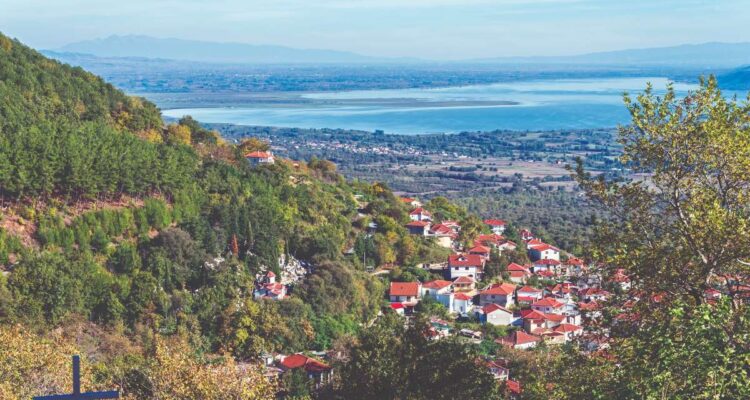Τα Άνω Πορόϊα αποτελούν ένα από τα διαμάντια του ιστορικού βουνού του Μπέλες. Είναι κτισμένα στους νότιους πρόποδες του δυτικού τμήματος του θρυλικού αυτού βουνού και σε μια από τις ωραιότερες χαράδρες του.
Αναπτυγμένα σχεδόν αμφιθεατρικά στις δυο αντικριστές πλαγίες της χαράδρας αυτής, υπερέχουν από κάθε άποψη απ’όλα τα γύρο ακριτικά χωριά. Κτισμένα σε υψόμετρο 380 μέτρων και σε απόσταση μόλις έξι χιλιόμετρα από την κορυφή του Μπέλες δηλαδή από τα ελληνοβουλγαρικά σύνορα, είναι αναπόσπαστα συνδεμένα με τη μοίρα και τις ιστορικές περιπέτειες του.
Η ιστορία αναφέρει ότι ομάδες οικογενειών κατατρεγμένων, από τη Μοσχόπολη, τα Γιάννενα, το Αργυρόκαστρο, τα Τρίκαλα, τα χωρία του Ολύμπου, της Πίνδου και του Γράμμου (όπως ο κοκκυόπλιος, η Αβδέλλα, το Περιβόλι, η Σαμαρίνα, το Μέτσοβο, το Νυμφαίο και πολλά άλλα) ήταν οι πρώτοι μετανάστες και φυλλάδες που αποτέλεσαν τους πυρήνες του πληθυσμού των νέων οικισμών όπως τα Πορόϊα, η Ράμνα, η Βετρίνα που βρίσκονται στις πλαγιές του Μπέλες.
Η ονομασία Πορόϊα φαίνεται ότι προϋπήρχε της εγκαταστάσεως στην περιοχή των νέων αποίκων. Προφανώς ο νέος οικισμός ονομάσθηκε Άνω Πορόϊα προς διάκριση από τον προϋπάρχοντα, ο πληθυσμός του οποίου αποτελείται από Τούρκους φερμένους από τα βάθη της Μικρά Ασίας για εποικισμό των αραιοκατοικημένων περιοχών, που είχαν ερημωθεί από τις συνεχείς επιδρομές και τα πολεμικά γεγονότα. Έτσι δημιουργήθηκαν οι δυο χωριστοί οικισμοί :Τα Άνω (Πορόι Μπαλαά) με αποκλειστικό Ελληνικό πληθυσμό στην αρχή, και τα Κάτω (Πορόι Ασίας) αποκλείστηκα κατοικημένο από Τουρκικό πληθυσμό. Πορόϊα στη σλαβική γλώσσα σημαίνει χείμαρρος. Όμως Παρά τη σλαβική ονομασία, η ονομασία Πορόϊα είναι καθαρά ελληνικής καταγωγής. Προέρχεται από συμφυρμό των λέξεων Πόρος (διάβαση, πέρασμα) και ροιά (ρέω, ροή) συνδυάζοντας την υπερκείμενη του χώρου μοναδική προς τον βορρά διάβαση του Μπέλες προς τη περίφημη Σιδερόπορτα με τα άφθονα ρέοντα νερά απ΄ τις πηγές του βουνού. Κατ΄ άλλη έκδοση η ονομασία μπορεί να θεωρηθεί ότι προέρχεται και από το απόκρημνο του εδάφους.
Τα Άνω Πορόϊα και όλα τα ακριτικά χωριά του Μπέλες δέχτηκαν στοργικά την ανάλογη μερίδα προσφύγων και κατ΄ εξοχήν προερχόμενων από τον Πόντο που εγκαταστάθηκαν στις περιοχές, των ανταλλαγέντων Τούρκων και Βουλγάρων.
Αν και ακραίος και παραμεθόριος οικισμός, τα Άνω Πορόϊα επικοινωνούν άμεσα με το Σιδηρόκαστρο, την πόλη των Σερρών και την Θεσσαλονίκη και γενικά με όλα τα αστικά κέντρα.
Ο Σιδηροδρομικός σταθμός Πορόϊων που εγκαταστάθηκε από την αρχή στη θέση που βρίσκεται και σήμερα, (ανακαινισμένος λόγω των διαφόρων καταστροφών που υπέστη στη διάρκεια των πολέμων) εξελίχθηκε με τον καιρό σε ένα σπουδαίο κέντρο ανθρώπων και εμπορευμάτων που συντέλεσε στην αλματική ανάπτυξη όλης της περιοχής. Απείχε από τα Πορόϊα μόλις 2 χιλιόμετρα και ανάλογα από τα γύρο χωριά, ώστε η προσπέλασης σ’ αυτόν να είναι πολύ εύκολη και σύντομη.
Η ευκολότερη πλέον επαφή με τα Αστικά Κέντρα του Νομού και κυρίως με τη Θεσσαλονίκη, δημιούργησε για τα Πορόϊα και ολόκληρη την περιοχή μια καινούργια εποχή οικονομικής ανάπτυξης και προόδου και έκδηλης κοινωνικής προσαρμογής προς ένα νέο περισσότερο πολιτισμένο τρόπο ζωής.
Τις νέες αυτές συνθήκες ζωής επωφελήθηκε κυρίως ο Ελληνικός πληθυσμός των Πορόϊων, για μια πληρέστερη εμπορική και κοινωνική οργάνωση ώστε στην περίοδο εκείνη μέχρι της απελευθερώσεως το 1913 τα Άνω Πορόϊα να έχουν φθάσει σε μία αξιοζήλευτη ακμή. Με τα διάφορα καταστήματα εργαστήρια, παντοπωλεία, τα καφενεία, μαζί με το λαμπρό Ελληνικό Κοινοτικό Σχολείο έδιναν τον τόνο μιας Εθνικής ανάτασης και μιας αναμφισβήτητα πνευματικής και κοινωνικής υπεροχής των Ελληνικών απέναντι στους αλλοεθνείς κατοίκους.
Copyright 2023 © Created By Diadyktio, All Rights Reserved.
To provide the best experiences, we and our partners use technologies like cookies to store and/or access device information. Consenting to these technologies will allow us and our partners to process personal data such as browsing behavior or unique IDs on this site and show (non-) personalized ads. Not consenting or withdrawing consent, may adversely affect certain features and functions.
Click below to consent to the above or make granular choices. Your choices will be applied to this site only. You can change your settings at any time, including withdrawing your consent, by using the toggles on the Cookie Policy, or by clicking on the manage consent button at the bottom of the screen.

Congratulation!